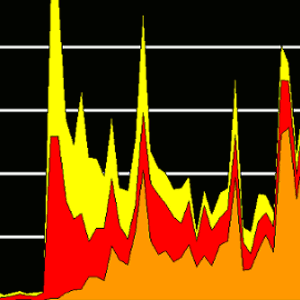Catastrophic Frequencies
Introduction
Early communications researchers posited that the Culture Industries (Horkheimer & Adorno 2006) and the Society of the Spectacle (Debord 1994) always reinforce power in the dominant paradigm. Via media and culture, the ideology of the mode of production impresses itself upon the minds, language and arts of society, consequently the ideology itself could be examined by studying its products.
Mass culture requires (and thus creates) shared symbols, metaphors, myths, histories, and a common language which transcends mere agreement on definitions and forms of grammar. Because “the language and gestures of listeners and spectators are more deeply permeated by the patterns of the culture industry than ever before” (Horkheimer, p.71) and “[p]eople use words and expressions which they either have ceased to understand at all or use only according to their behavioral functions” (ibid, p.70), it becomes necessary to investigate the process by which the culture industry transforms historic events into cultural units. One form identified by Horkheimer and Adorno is the bourgeois tragedy, “included in society’s calculations and affirmed as a moment of the world,” (ibid, p.61) a “house of moral correction” (ibid, p.62) and a “threat to destroy anyone who does not conform” (ibid, p.61).
The media record of the Bush Years (2000-2008), marked by several historic catastrophes (Harper, 2009), offers fertile ground for investigation of the creation of symbolic libraries in a mass culture where repetition of Signified failures of power become semantic tools of ideology. While the “nuances (are) still beyond the reach of experimental methods” (Horkheimer, p.71), this paper attempts to use crude machine-assisted word frequency to identify patterns indicating the commodification of a catastrophe into a tragic mythology.
Roland Barthes’ Mythologies describes a methodology for describing the construction of cultural units. Because the nomenclature is circular and recursive, an example can help illuminate what is here meant by signs, myths and mythologies.
The phenomenon of written history in a literate society provides “an artificially extended and verifiable memory of objects and events not present to sight or recollection” understood through “symbols rather than things” (Innis 1972, p.10). The construction of a people’s common history requires general consensus upon the signs which signify historical events. When historical events are recorded in written form, the variety of signs used to signify must be reduced to those made available by the typographical technology of the language, before being further constrained to distinguish one event from another. Whereas photographs of soldiers raising a flag (Rosenthal 1945), children running from a fireball (Ut 1972) and a hooded man standing on a box (Unknown 2003) today signify both war generally but also their respective wars so clearly as to require no further context or explanation, the written sign “war” must be augmented with prefixes and suffixes to distinguish one conflagration from another: “World War II”, “Vietnam War” and “Iraq War”, respectively. In other words, the technological demands of written script in the English language force the representation of historic events by a generally accepted sequence of alphanumeric characters.
This observation opens the door to machine analysis of texts: “When using units of analysis, such as words or other symbols, the computer can generate perfectly reliable frequency counts” (West 2008, p.14). To the extent that the signification of historical events is limited to a set of recognizable signs, the computer can report the frequency that signified historical events are invoked.
Frequency is well explored activity in the field of communication and “was a main activity of content analysis in the 1930s and 1940s” (ibid, p. 16). Recognizing the challenges of making inferences from text when assuming that “frequency is a function of intensity” (ibid, 2008) and therefore of importance, this paper equates the use of a sign in a text with the invocation of the historical event which the sign represents. Frequency over time is a measure of how often a historical event is invoked to explain the world, and is therefore a measure of the historical event’s power as a culture’s myth or mythology. Just as the Bombing of Pearl Harbor in 1941 was invoked to explain the 2001 terrorist attacks on the World Trade Center in New York, so too will more recent history be invoked to explain future news cycles.
